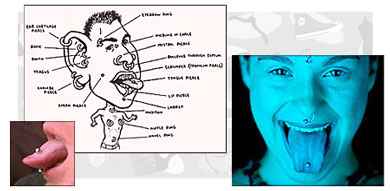Body piercing

Fashion Synopsis
In Aerosmith's 1993 “Cryin” video, a then-unknown Alicia Silverstone got a navel ring and a tattoo to spite her cheating ex-boyfriend and celebrate her newly discovered girl power. And before long, legions of high school girls marched down to their local tattoo parlors for a little pierce and a little paint—because they wanted to rule like the riot grrrls did.
Body piercing began as a tribal art, a way to achieve greater spirituality through body modification like tattooing and scarification. America’s preeminent scholar and practitioner of ‘modern primitivism,’ Fakir Musafar, brought primal body art to mass acceptance when he showcased his own body modification. While the modern primitives still seek higher knowledge through physical sensation, the popularity of modern body piercing has become more of a fashion than a spiritual quest.
Body piercing was first practiced in the U.S. within the sado-masochist society, and many still connect piercing with sexual deviancy. That association certainly still exists, but piercings are now sought out for many reasons, including spirituality, shock value, expression of individuality, and simply because they ‘look cool.’ Whatever the reason, alternative became mainstream, and piercing punctured through the barriers to become a generally acceptable form of body decoration for the new millennium. Piercings were everywhere on TV, in music, and soon the stigma was gone. The media used piercings as quick way to represent a child of the tumultuous teens, filled with individuality and angst. Commercials featured thirteen-year-old girls, instantly recognizable as hip, young, sassy things by the presence of a nose ring.
Years ago, having more than one earring hole meant you danced on the edge of society, pushed the envelope, and thumbed your nose to conservative authority. When men pierced their ears in the 70’s, it was shameless, and a direct statement about their homosexuality. But within a few years, that stigma was replaced by a cool factor, and men not only had one, but two, or two dozen.
By the 90’s, a dozen holes in the ear seemed tame compared to the other holes elsewhere in the body. Piercing lips, tongues, eyebrows, navels, genitals and nipples was only the beginning. Not only are earlobes being stretched out in intimation of African tribes, but the technique of pocketing (attaching flesh via metal rods pierced into the skin) offers the next step towards what can be done to manipulate the body with modern tribal decoration.
Today, pre-teens parade around with eyebrow and nose rings, with nary a blink more than if it were their ears. But even this shock value fades fast when forty-year-old moms accompany their teenage daughters to the salon so that they can both get their navels pierced.
